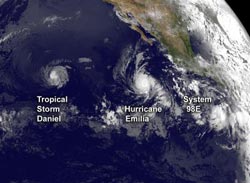Satellite sees 2 tropical cyclones chase Tropical Storm Daniel

NOAA's GOES-15 satellite captured the three tropical cyclones spinning in the eastern Pacific Ocean today, July 10, 2012, at 1200 UTC (8 a.m. EDT). Tropical Storm Daniel is farthest west, followed by major hurricane Emilia, and developing low pressure System 98E. Credit: NASA/NOAA GOES Project<br>
In an image captured by NOAA's GOES-15 satellite, all three tropical cyclones were seen spinning in the eastern Pacific Ocean on July 10, 2012 at 1200 UTC (8 a.m. EDT). Daniel has weakened from a hurricane to a tropical storm and appears smaller than Hurricane Emilia.
Daniel is about 180 miles in diameter, while Emilia is over 250 miles in diameter. System 98E, the low pressure system east of Emilia, is dwarfed by the large hurricane. NOAA manages the GOES-15 satellite, and NASA's GOES Project at the NASA Goddard Space Flight Center in Greenbelt, Md. uses the data to create images and animations of weather around the U.S.
Tropical Storm Daniel's winds were now down to 65 mph (100 kmh). At 8 a.m. PDT/11 a.m. EDT, the center of Tropical Storm Daniel was located near latitude 15.3 north…longitude 135.1 west. That's about 1,350 miles (2, 175 km) east of Hilo, Hawaii. It is moving west near 16 mph (26 kmh) and is expected to keep moving in that direction over the next couple of days. Daniel is expected to weaken to tropical depression status by July 11.
On July 10 at 5 a.m. EDT, Emilia's maximum sustained winds were near 140 mph (220 kmh). By 11 a.m. EDT, Emilia's maximum sustained winds dropped to 130 mph (215 kmh) and was still holding onto Category 4 hurricane status. Emilia was located about 685 miles (1100 km) south-southwest of the southern tip of Baja California. Emilia is moving at 10 mph (17 kmh) to the west-northwest.
System 98E is slowly coming together, and has a 40 percent chance of becoming a tropical depression in the next day or two.
Media Contact
More Information:
http://www.nasa.govAll latest news from the category: Earth Sciences
Earth Sciences (also referred to as Geosciences), which deals with basic issues surrounding our planet, plays a vital role in the area of energy and raw materials supply.
Earth Sciences comprises subjects such as geology, geography, geological informatics, paleontology, mineralogy, petrography, crystallography, geophysics, geodesy, glaciology, cartography, photogrammetry, meteorology and seismology, early-warning systems, earthquake research and polar research.
Newest articles

Making diamonds at ambient pressure
Scientists develop novel liquid metal alloy system to synthesize diamond under moderate conditions. Did you know that 99% of synthetic diamonds are currently produced using high-pressure and high-temperature (HPHT) methods?[2]…

Eruption of mega-magnetic star lights up nearby galaxy
Thanks to ESA satellites, an international team including UNIGE researchers has detected a giant eruption coming from a magnetar, an extremely magnetic neutron star. While ESA’s satellite INTEGRAL was observing…

Solving the riddle of the sphingolipids in coronary artery disease
Weill Cornell Medicine investigators have uncovered a way to unleash in blood vessels the protective effects of a type of fat-related molecule known as a sphingolipid, suggesting a promising new…





















